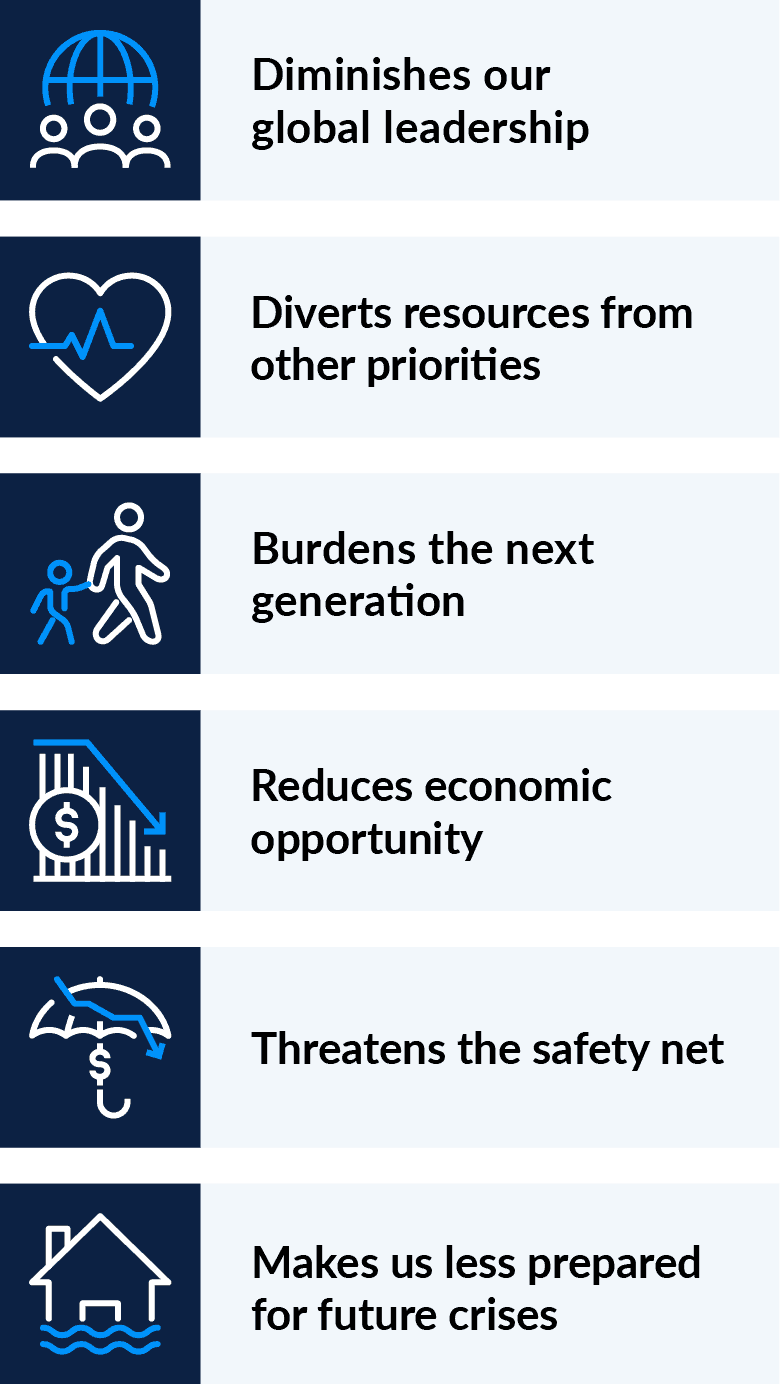what is the National Debt today?
That's
$112,846
for everysingle person in America
Why is the National Debt so high?
America's growing debt is the result of simple math — each year, there is a mismatch between spending and revenues.
When the federal government spends more than it takes in, it has to borrow money to cover that annual deficit. And each year’s deficit adds to our growing national debt.
Historically, the largest deficits were caused by increased spending around national emergencies like major wars or the Great Depression.
Today, deficits are caused mainly by predictable structural factors: our aging baby-boom generation, rising healthcare costs, higher interest rates, and a tax system that does not bring in enough money to pay for what the government has promised its citizens. Moving forward, it will be critical for America’s leaders to address our rising debt, and its structural factors, which are described below.
the more we borrow, the more we pay in interest on that debt.
our debt over time
Three main drivers of our growing national debt
Demographics
America is undergoing significant demographic change. Our society is aging as the large baby-boom generation begins to retire — 10,000 people will turn 65 every day through 2030. Moreover, people are expected to live longer, on average. That is great news, but it means that we must prepare for the financial needs of longer retirement.
Those huge demographic trends put increasing pressure on the federal budget — and in particular on vital programs that serve older Americans like Social Security and Medicare.
Rising Healthcare Costs
In many ways, healthcare is the most important issue for our nation’s fiscal and economic future. It represents nearly one-fifth of our entire economy, and it is one of the fastest-growing parts of the budget.
The U.S. healthcare system is the most expensive in the world, but we do not really get what we pay for. We spend nearly twice as much on healthcare as other advanced nations, but our system does not provide better overall health outcomes. Improving the performance of the U.S. healthcare system will not only improve Americans’ lives, it will help stabilize our fiscal and economic outlook.
Inadequate Revenues
It would be one thing if our tax code was designed to fund all the promises we are making. But it is not.
The U.S. tax system does not generate enough revenues to cover the spending policymakers have enacted. This rapidly growing imbalance between revenues and spending leads to higher and higher annual deficits, resulting in mounting debt.
what is the National Debtcosting us?
The interest adds up fast. As the debt grows, so does the interest paid by the government.
Similar to a home or car loan, interest payments represent the price we pay to borrow money. As we borrow more and more, federal interest costs rise and compound. Rapidly growing interest payments are a burden that hinders our future economy.
EVERY DAY, WE SPEND OVER $2.6 BILLION ON INTEREST
Interest is the fastest growing part of the federal budget.
In ten years, interest will nearly double from where it is today.
whY DOES the National Debt MATTER?
This is about our future. What makes America strong is our willingness to build and leave a better future for the next generation. Unfortunately, our growing debt is doing the opposite.
America faces many challenges including rising inequality, unaffordable healthcare, climate change, education affordability, and unpredictable security threats. To address these challenges we will need significant resources. Every dollar that goes toward interest payments means less resources available to invest in a stronger, more resilient future.
less resources available to invest in a stronger, more resilient future.
Being irresponsible with our budget is simply not fair to our kids and grandkids, who will inherit this burden.
Skyrocketing national debt…


